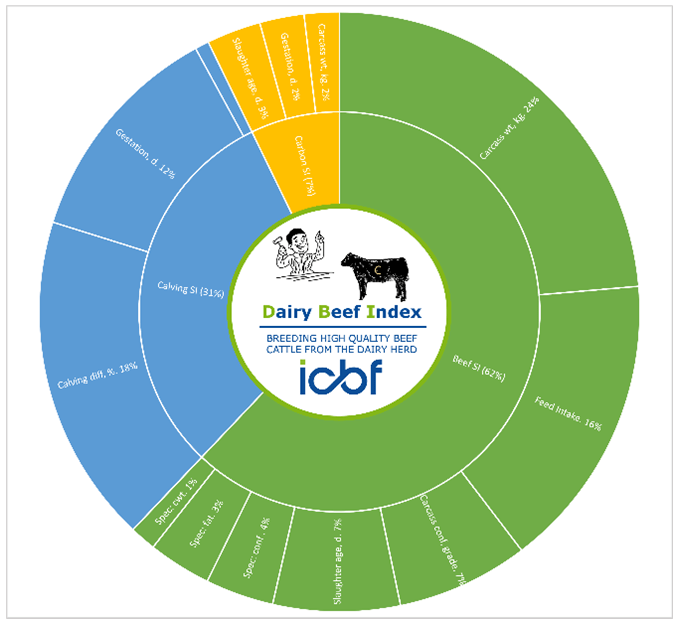29 March 2023
Selecting beef sires on more than calving ease and short gestation

On many dairy farms, the decision of what beef bull to use on their cows is often based on having a very low calving difficulty along with having as short a gestation as possible.
While it makes sense to use these type of bulls to reduce difficult calvings and increase days in milk, Fergal Maguire, DairyBeef 500 Advisor, explains why these traits often come at the expense of beef traits such as carcass weight and live weight gain. This is resulting in beef farmers rearing these calves struggling to have adequate carcass weights for factory specifications, which is having a negative impact on the level of income that these dairy calf to beef enterprises can generate. A struggling dairy calf to beef sector is not good news for dairy farmers.
The Dairy Beef Index (DBI) is a tool for dairy farmers to improve the quality of their beef calves without compromising on essential characteristics such as easy calving and short gestation. The DBI comprises of three sub-indexes. These are the calving sub-index, beef sub-index and carbon sub-index; 62% of the weighting or relative emphasis is towards the beef sub-index, 31% is weighted to the calving sub-index and the carbon sub-index is 7%.
In Figure 1 we can see that calving sub-index is made up of three further sub-indexes – calving difficulty, gestation and calf mortality, with the highest weighting towards calving difficulty at 35%. The beef sub-index is comprised of seven further parts, including: carcass weight; feed intake; carcass conformation grade; slaughter age; conformation specification; fat specification; and carcass weight specification. The highest weighting in the beef sub-index is carcass weight at 24%. The carbon sub-index is comprised of three further parts – carcass weight, gestation and age of slaughter.
Figure 1. Updated Relative Emphasis of the Dairy Beef Index (DBI). January 2023 (ICBF)

Many dairy farmers will be familiar with the Economic Breeding Index (EBI). The DBI is similar in that it is expressed in euros and the higher the euro value the better. A bull with a high DBI should pass on more desirable characteristics to its progeny than a bull with a low DBI. Consequently, progeny from a high DBI bull should generate more revenue than a low DBI bull.
In a study carried out by Berry and Ring, 2020, sires that ranked best on calving traits alone (i.e., easy calving, short gestation, and low calf mortality) were compared with sires that ranked best on the DBI. Bulls that ranked high on DBI delivered heavier and more conformed carcasses compared to bulls ranked best on calving traits alone. The higher DBI sires achieved the additional performance without increasing the incidence of cow calving difficulty, gestation length and calf mortality.
The additional revenue to the finisher that slaughtered 20 progeny from sires that ranked best on DBI over sires that ranked best on calving performance was €829.40. For calving performance, the monetary benefit to the dairy farmer that had 20 calves from high DBI sires compared to sires that ranked best on calving performance was €79.60.
However, as there are three sub-indexes that feed into the final DBI figure, the top DBI bull won’t necessary give the farmer the best calf. Farmers will need to drill down into the DBI figures and focus on the beef sub-index to produce a calf that has a high Commercial Beef Value (CBV). Herds with an average EBI beef sub-index of -€2 would require beef bulls with a minimum DBI beef sub-index of €88 to achieve progeny ranking of 4 stars under the CBV dairy-beef category.
Table 1: Minimum required DBI beef sub-index of beef bulls (AA/HE) to achieve at least a four-star CBV dairy-beef calf
| Herd rank on Dairy Beef sub-index | Herd Dairy Beef sub-index | Beef bull beef sub-index (DBI) |
|---|---|---|
| Average of one-star herds | -€13 | €99 |
| Average of two-star herds | -€5 | €91 |
| Average of three-star herds | -€2 | €88 |
| Average of four-star herds | €0 | €86 |
| Average of five-star herds | +€4 | €82 |
For a dairy farmer aiming to produce quality beef calves, the farmer needs to group cows according to the risk of having a difficult calving (e.g. maidens, second calvers or small framed cows and mature cows). Next, they need to identify the maximum calving difficulty that they are happy with for each group of cows and then select the bull with the highest beef sub-index at this level of calving difficulty to give the calf the highest CBV at the other side. ICBF Dairy Beef Bull lists can be found here.
Using bulls of high beef merit
In the below video, Seamus Commons – a dairy farmer from Co. Meath, milking 160 cows – explains why he is using bulls of high beef merit on his farm.
For more information on the DairyBeef 500 Campaign, click here. This article was originally published as part of the Teagasc DairyBeef 500 Spring Series on Agriland.
Also read: Breathing new life into a calf-to-beef system in Co. Meath
Also read: Getting ready for weaning
Also read: Making use of the CBV in calf purchasing this spring
